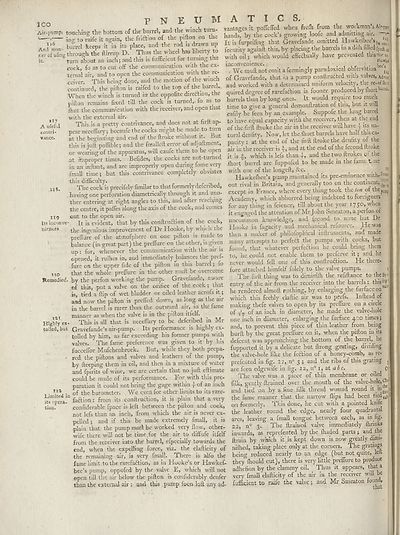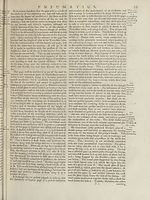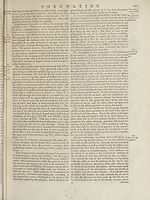Encyclopaedia Britannica > Volume 15, PLA-RAM
(116) Page 100
Download files
Complete book:
Individual page:
Thumbnail gallery: Grid view | List view

ICO
Air-pump.
116
And man-
j;er of uiing
it.
pneumatics.
*17
A ufeful
contri¬
vance.
11$.
1X9
Its iuconve
tiiencea
xao
Remedietl
iat
HigWy ex
toiled, but
124
IJmited in
its opera¬
tion.
touching the bottom of the brurel, and the winch tuiu-
inp- to raife it again, the fritlion of the pifton on tiK
barrel keeps it in its place, and the rod is drawn up
through the ftirrup D. Thus the wheel has liberty to
turn about an inch; and this is fufheient lor turning tne
cock, fo as to cut off the communication with the ex¬
ternal air, and to open the communication with the re¬
ceiver. This being done, and the motion of the winch
continued, the pifton is raifed to the top of the barre,.
When the winch is turned in the oppofite direftion, the
pifton remains fixed till the cock is turned,, fo as to
fhut the communication with the receiver, and open that
with the external air.
This is a pretty contrivance, and does not at lirit ap¬
pear neceffary; becaufe the cocks might be made to turn
at the beginning and end of the ftroke without it. Ba-
this is juft poflible; and the fmalleft error of adjuftment,
or wearing of the apparatus, will caufe them to be open
at improper times. Befides, the cocks are not- turned
in an inftant, and are improperly open during fome very
1'mall time; but this contrivance completely obviates
this difficulty. r -l j
The cock is precifely fimilar to that formerly defenbed,
having one perforation diametrically through it and ano¬
ther entering at right angles to this, and after reading
the centre, it paffes along the axis of the cock, and comes
out to the open air.
It is evident, that by this conftrufti«n of the cock,
the ingenious improvement of Dr Hooke, by which tne
preffure of the atmofphere on one pifton is made to
balance (in great part) the preffure on the other, is given
up: for, wdienever the communication with the air is
opened, it rufhea in, and immediately Jialances the pn f-
fure on the upper fide of the pifton in this barrel; fo
that the whole preffure in the other mult be overcome
by the perfon working the pump. Gravefande, aware
of this, put a valve on the orifice of the cock ; that
is, tied a flip of wet bladder or oiled leather acrofs it;
and now the pifton is preffed down, as long as the air
in the barrel is rarer than the outward air, in the fame
manner as when the valve is in the pifton ittelf.
This is all that is neceffary to be deferibed in Mr
Gravefande’s air-pump. Its performance is highly ex¬
tolled by him, as far exceeding his former pumps with
valves. The fame preference was given to it. by his
fucceffor Mufchenbroek. But, while they both prepa¬
red the piftons and valves and leathers of the pump,
by fteeping them in oil, and then in a mixture of water
and fpmts of wine, we are certain that no juft eftnnate
could be made of its performance. For with this pre¬
paration it could not bring the gage within -f of an inch
of the barometer. We even fee other limits to its rare-
fadion : from its conltrudion, it is plain that a very
confiderable fpace is left between the pifton and cock,
not lefs than an inch, from which the air is never ex¬
pelled ; and if this be made extremely final!, it is
plain that the pump muft be worked very flow, other-
wdfe there will not be time for the air to diffufe itfelf
from the receiver into the barrel, efpecially towards the
end, when the expelling force, viz., the elafticity of
the remaining air, is very fmall. There is alfo the
fame limit to the rarefadion, as in Hooke’s or Hawkef-
bee’s pump, oppofed by the valve E, which will not
open till the air below the pifton is confiderably denfer
than the external air ; and this pump toon loft any ad¬
vantages it poffeffed when frcfli from the workman’s A-ir-paj
hands, by the cock’s growing loofe and admitting air.
It is furprifing that Gravefande omitted Hawkelbee S[B ob^
fecurity againft this, by placing the barrels in a diih filledfpe& ia]
with oilwhich would effedually have prevented this nor to
. • Uawkcl
inconvenience. _ ^ . tee’s.
. We muit not omit a feemingly paradoxical obicivation ^
of Gravefande, that in a pump conftruded vritn valves, Ad^nt
and worked with a determined uniform velocity, the re-of ik*
quired degree of rai'efadion is fooner produced ay llioit a‘re •
barrels than by long ones. It would requiie too much
time to give a general demonftration of tins, out it will
eafily be feen by an example. Suppofe the long barrel
to have equal capacity with the receiver, then at tlm end
of the fir ft ftroke the air in the receiver will have ft its na¬
tural denfity. Now, let the fliort barrels have half this ca-
pacity : at the end of the firft ftroke the uenlity of the
air in the receiver is y, and at the end of the fecond ftioke
it is ij-, which is lets than 4» and the two ftrokes o: the
fliort barrel are fuppofed to be made in the fame tinie
with one of the longeft, <Scc. __ ,
Hawkefbee’s pump maintained its pre-eminence with-
out rival in Britain, and generally too on the continent,
except in France, where every thing took the ton ol the ^
Academy, which abhorred being indebted to foreigners
for any thing in faience, till about the year lyS0* when
it engaged the attention of Mr John Smeaton, a perfon ot
uncommon knowledge, and fecond to none but Dr
Hooke in fagaeity and mechanical refource. He was
then a maker of philofophical inftruments, and made
many attempts to perfect the pumps with cocks, but
found, that whatever perfedlion he could bring them
to, he could not enable them to preferve it; and he
never would fell one of this conitruftion. He there¬
fore attached himfelf folely to the valve pumps. i
The firft thing was to dimimih the refiftance to the Bye
entry of the air from the receiver into the barrels: thisj^
he rendered almoft nothing, by enlarging the fin-face onva
which this feebly elaftic air was to prefs. Inftead of
making thefe valves to open by7- its preffure on a circle
of of an inch in diameter, he made the valve-hole
one inch in diameter, enlarging the furface 4-0 times;
and, to prevent this piece of thin leather from being
burft by the great preffure on it, when the pifton in its
defeent was approaching the bottom of the barrel, lie
fupported it by a delicate but ftrong grating, dividing
the valve-hole like the feftion of a honey-comb, as re-
prefented in fig. 2 2, n° 3 ; and the ribs of this grating j
are feen edgevvife in fig. 22, n° I, at _ Cl
The valve was a piece of thin membrane or oiled ^
filk, gently {trained over the mouth of the valve-hole,Clw;
and tied on by a fine filk thread wound round it _iit^|
the fame manner that the narrow flips had been
on formerly. This done, he cut with a pointed knife
the leather round the edge,, nearly four quadrants!
arcs, leaving a fmall tongue between each, as in fig.
22, n° 3. The {trained valve immediately {brinks
inwards, as reprefented by the fhaded parts; and the
{train by which it is kept down is now greatly dinu-
nifhed, taking place only at the corners. The gratings
being reduced nearly to an edge (but not quite, left
they°fhould cut), there is very little preffure to produce
adhefion by the clammy oil. Thus it appears, that a
very fmall elafticity of the air in the receiver will be
Efficient to raife the valve; and Mr Smeaton found,
that
Air-pump.
116
And man-
j;er of uiing
it.
pneumatics.
*17
A ufeful
contri¬
vance.
11$.
1X9
Its iuconve
tiiencea
xao
Remedietl
iat
HigWy ex
toiled, but
124
IJmited in
its opera¬
tion.
touching the bottom of the brurel, and the winch tuiu-
inp- to raife it again, the fritlion of the pifton on tiK
barrel keeps it in its place, and the rod is drawn up
through the ftirrup D. Thus the wheel has liberty to
turn about an inch; and this is fufheient lor turning tne
cock, fo as to cut off the communication with the ex¬
ternal air, and to open the communication with the re¬
ceiver. This being done, and the motion of the winch
continued, the pifton is raifed to the top of the barre,.
When the winch is turned in the oppofite direftion, the
pifton remains fixed till the cock is turned,, fo as to
fhut the communication with the receiver, and open that
with the external air.
This is a pretty contrivance, and does not at lirit ap¬
pear neceffary; becaufe the cocks might be made to turn
at the beginning and end of the ftroke without it. Ba-
this is juft poflible; and the fmalleft error of adjuftment,
or wearing of the apparatus, will caufe them to be open
at improper times. Befides, the cocks are not- turned
in an inftant, and are improperly open during fome very
1'mall time; but this contrivance completely obviates
this difficulty. r -l j
The cock is precifely fimilar to that formerly defenbed,
having one perforation diametrically through it and ano¬
ther entering at right angles to this, and after reading
the centre, it paffes along the axis of the cock, and comes
out to the open air.
It is evident, that by this conftrufti«n of the cock,
the ingenious improvement of Dr Hooke, by which tne
preffure of the atmofphere on one pifton is made to
balance (in great part) the preffure on the other, is given
up: for, wdienever the communication with the air is
opened, it rufhea in, and immediately Jialances the pn f-
fure on the upper fide of the pifton in this barrel; fo
that the whole preffure in the other mult be overcome
by the perfon working the pump. Gravefande, aware
of this, put a valve on the orifice of the cock ; that
is, tied a flip of wet bladder or oiled leather acrofs it;
and now the pifton is preffed down, as long as the air
in the barrel is rarer than the outward air, in the fame
manner as when the valve is in the pifton ittelf.
This is all that is neceffary to be deferibed in Mr
Gravefande’s air-pump. Its performance is highly ex¬
tolled by him, as far exceeding his former pumps with
valves. The fame preference was given to it. by his
fucceffor Mufchenbroek. But, while they both prepa¬
red the piftons and valves and leathers of the pump,
by fteeping them in oil, and then in a mixture of water
and fpmts of wine, we are certain that no juft eftnnate
could be made of its performance. For with this pre¬
paration it could not bring the gage within -f of an inch
of the barometer. We even fee other limits to its rare-
fadion : from its conltrudion, it is plain that a very
confiderable fpace is left between the pifton and cock,
not lefs than an inch, from which the air is never ex¬
pelled ; and if this be made extremely final!, it is
plain that the pump muft be worked very flow, other-
wdfe there will not be time for the air to diffufe itfelf
from the receiver into the barrel, efpecially towards the
end, when the expelling force, viz., the elafticity of
the remaining air, is very fmall. There is alfo the
fame limit to the rarefadion, as in Hooke’s or Hawkef-
bee’s pump, oppofed by the valve E, which will not
open till the air below the pifton is confiderably denfer
than the external air ; and this pump toon loft any ad¬
vantages it poffeffed when frcfli from the workman’s A-ir-paj
hands, by the cock’s growing loofe and admitting air.
It is furprifing that Gravefande omitted Hawkelbee S[B ob^
fecurity againft this, by placing the barrels in a diih filledfpe& ia]
with oilwhich would effedually have prevented this nor to
. • Uawkcl
inconvenience. _ ^ . tee’s.
. We muit not omit a feemingly paradoxical obicivation ^
of Gravefande, that in a pump conftruded vritn valves, Ad^nt
and worked with a determined uniform velocity, the re-of ik*
quired degree of rai'efadion is fooner produced ay llioit a‘re •
barrels than by long ones. It would requiie too much
time to give a general demonftration of tins, out it will
eafily be feen by an example. Suppofe the long barrel
to have equal capacity with the receiver, then at tlm end
of the fir ft ftroke the air in the receiver will have ft its na¬
tural denfity. Now, let the fliort barrels have half this ca-
pacity : at the end of the firft ftroke the uenlity of the
air in the receiver is y, and at the end of the fecond ftioke
it is ij-, which is lets than 4» and the two ftrokes o: the
fliort barrel are fuppofed to be made in the fame tinie
with one of the longeft, <Scc. __ ,
Hawkefbee’s pump maintained its pre-eminence with-
out rival in Britain, and generally too on the continent,
except in France, where every thing took the ton ol the ^
Academy, which abhorred being indebted to foreigners
for any thing in faience, till about the year lyS0* when
it engaged the attention of Mr John Smeaton, a perfon ot
uncommon knowledge, and fecond to none but Dr
Hooke in fagaeity and mechanical refource. He was
then a maker of philofophical inftruments, and made
many attempts to perfect the pumps with cocks, but
found, that whatever perfedlion he could bring them
to, he could not enable them to preferve it; and he
never would fell one of this conitruftion. He there¬
fore attached himfelf folely to the valve pumps. i
The firft thing was to dimimih the refiftance to the Bye
entry of the air from the receiver into the barrels: thisj^
he rendered almoft nothing, by enlarging the fin-face onva
which this feebly elaftic air was to prefs. Inftead of
making thefe valves to open by7- its preffure on a circle
of of an inch in diameter, he made the valve-hole
one inch in diameter, enlarging the furface 4-0 times;
and, to prevent this piece of thin leather from being
burft by the great preffure on it, when the pifton in its
defeent was approaching the bottom of the barrel, lie
fupported it by a delicate but ftrong grating, dividing
the valve-hole like the feftion of a honey-comb, as re-
prefented in fig. 2 2, n° 3 ; and the ribs of this grating j
are feen edgevvife in fig. 22, n° I, at _ Cl
The valve was a piece of thin membrane or oiled ^
filk, gently {trained over the mouth of the valve-hole,Clw;
and tied on by a fine filk thread wound round it _iit^|
the fame manner that the narrow flips had been
on formerly. This done, he cut with a pointed knife
the leather round the edge,, nearly four quadrants!
arcs, leaving a fmall tongue between each, as in fig.
22, n° 3. The {trained valve immediately {brinks
inwards, as reprefented by the fhaded parts; and the
{train by which it is kept down is now greatly dinu-
nifhed, taking place only at the corners. The gratings
being reduced nearly to an edge (but not quite, left
they°fhould cut), there is very little preffure to produce
adhefion by the clammy oil. Thus it appears, that a
very fmall elafticity of the air in the receiver will be
Efficient to raife the valve; and Mr Smeaton found,
that
Set display mode to:
![]() Universal Viewer |
Universal Viewer | ![]() Mirador |
Large image | Transcription
Mirador |
Large image | Transcription
Images and transcriptions on this page, including medium image downloads, may be used under the Creative Commons Attribution 4.0 International Licence unless otherwise stated. ![]()
| Encyclopaedia Britannica > Encyclopaedia Britannica > Volume 15, PLA-RAM > (116) Page 100 |
|---|
| Permanent URL | https://digital.nls.uk/191902284 |
|---|
| Attribution and copyright: |
|
|---|
| Description | Ten editions of 'Encyclopaedia Britannica', issued from 1768-1903, in 231 volumes. Originally issued in 100 weekly parts (3 volumes) between 1768 and 1771 by publishers: Colin Macfarquhar and Andrew Bell (Edinburgh); editor: William Smellie: engraver: Andrew Bell. Expanded editions in the 19th century featured more volumes and contributions from leading experts in their fields. Managed and published in Edinburgh up to the 9th edition (25 volumes, from 1875-1889); the 10th edition (1902-1903) re-issued the 9th edition, with 11 supplementary volumes. |
|---|---|
| Additional NLS resources: |
|

